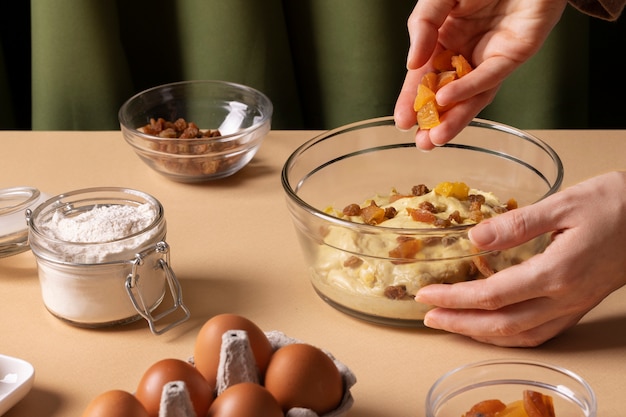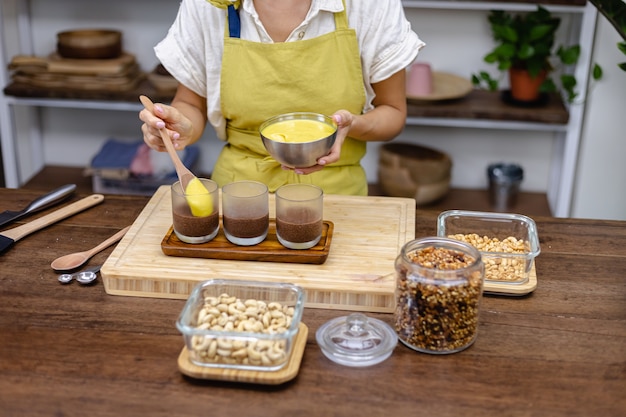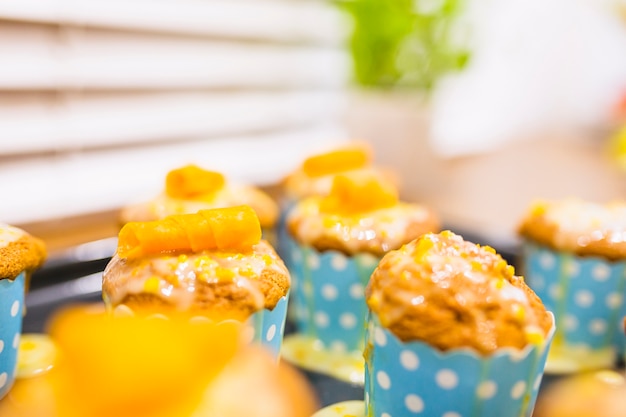Banana muffins hold a special place in my heart. The combination of sweet, soft, and slightly mushy banana with the fluffy texture of a muffin is simply irresistible. But as with any baking, the real magic lies in mastering the baking time. I've learned that knowing how long to bake those beauties to achieve that perfect texture and golden-brown hue makes all the difference. So, today, we're taking a deep dive into the world of banana muffin baking. We'll explore the factors that influence baking time and delve into the secrets of consistently producing those perfectly golden, moist muffins, every single time.
Part 1: The Great Banana Muffin Mystery

There's always a bit of a mystery surrounding baking, and banana muffins are no exception. You might follow a recipe to the letter, but your oven might be a bit of a rogue, or your muffins might be a bit denser than anticipated. I've had my share of banana muffin mishaps - some too dry, others still a little doughy in the middle. But through countless experiments and a little bit of trial and error, I've learned a few key things that have significantly improved my baking game. Let's break it down, step by step.
1.1 The Science of Banana Muffins
Let's talk about the science behind it all. Baking, in essence, is all about the chemistry of ingredients. Banana muffins, like any baked good, rely on a carefully orchestrated combination of ingredients to achieve that perfect texture and flavor. The flour provides structure, the sugar adds sweetness, and the bananas, of course, contribute that irresistible flavour and moisture. It's the interaction between these ingredients, influenced by temperature and time, that determines how the muffins turn out. The key lies in understanding how these elements work together.
The flour, for example, absorbs moisture and forms a network of gluten strands. The sugar acts as a sweetener and also helps to retain moisture. The bananas contribute their natural sugars, adding sweetness and moisture to the batter. The baking process involves a fascinating interplay of heat, moisture, and chemical reactions that transform the batter into a fluffy and delicious muffin. The way the gluten develops, the moisture evaporates, and the sugars caramelize all influence the final texture and flavor of the muffin.
1.2 The Baking Time Equation
Think of baking time like a puzzle, a complex equation with multiple variables. There's no one-size-fits-all answer. It's a combination of factors that determine how long your muffins need to bake to reach their peak of perfection. Here are some key factors to consider:
- Muffin Size: Smaller muffins bake faster than larger ones. This is because of their higher surface area to volume ratio, which allows heat to distribute more efficiently and reach the center of the muffin quicker.
- Oven Temperature: A hotter oven means faster baking. But be careful! Too high a temperature can lead to burning on the outside while the center remains raw.
- Batter Consistency: A wetter batter, like one with more mashed bananas, will take longer to bake than a drier batter. This is because the extra moisture needs more time to evaporate and for the internal structure to set.
- Muffin Tin Material: Darker metal pans absorb heat more quickly than lighter ones, which can lead to quicker baking. This is because the darker metal transfers heat more efficiently.
- Altitude: Baking at higher altitudes requires adjustments to baking time. The lower air pressure at higher altitudes means that liquids boil at a lower temperature, resulting in faster evaporation. This can lead to dry muffins if you don't adjust the baking time accordingly.
Part 2: Deciphering the Baking Time

Now, let's get into the nitty-gritty of figuring out the perfect baking time. There are a few tricks I've learned over the years, and they've made all the difference in consistently producing perfect banana muffins.
2.1 The Toothpick Test
This is the classic test for any baked good, and it's a lifesaver for banana muffins. When you insert a toothpick into the center of a muffin, it should come out clean. If there's batter clinging to the toothpick, it needs more time in the oven. But don't overdo it! A toothpick that comes out with just a few moist crumbs is perfectly acceptable, indicating that the muffin is cooked through.
2.2 The Firmness Test
Give your muffins a gentle press. They should feel firm to the touch, not jiggly or soft. This means the internal structure is set and they're ready to come out of the oven. You should be able to gently press on the muffin without it collapsing.
2.3 The Colour Test
Look for that beautiful golden-brown hue on top of your muffins. It's a sign they've reached that perfect stage of doneness. The colour should be evenly distributed, with no pale spots. But keep an eye on things! Over-baking can lead to dry, hard muffins.
Part 3: The Art of Baking Time Adjustment

Now, let's talk about adjusting baking time for those unexpected situations. We all know that ovens can be a bit temperamental, and even the same recipe can have slightly different results depending on various factors. Here's how to handle these situations:
3.1 Dealing with a Hot Oven
If your oven is running a little hot, it's likely that your muffins will bake faster. You might need to reduce the baking time by a few minutes to prevent over-baking. Keep an eye on the color and use the toothpick test to make sure they're done. You may need to start checking for doneness a couple of minutes earlier than the recipe suggests.
3.2 Dealing with a Cool Oven
On the other hand, if your oven runs a little cool, you might need to add a few minutes to the baking time. Again, keep an eye on the color and use the toothpick test to ensure those muffins are perfectly cooked through. Be patient and give them a few extra minutes if they seem to be taking longer than usual to reach the desired doneness.
3.3 Dealing with a Dense Batter
If your batter is a bit thicker than usual, it might need a few extra minutes in the oven to set properly. This is because the denser batter will hold onto more moisture, requiring a little longer to bake through. Make sure the toothpick comes out clean and that the muffin feels firm to the touch before removing them from the oven.
Part 4: The Banana Muffin Baking Time Table
Let's make this a little easier. Here's a general guideline for baking time based on muffin size and your oven temperature, but remember, this is just a guide. Always check for doneness using the toothpick and firmness tests.
| Muffin Size | Oven Temperature (°C) | Baking Time (Minutes) |
|---|---|---|
| Small (2.5 inches) | 180°C (350°F) | 15-18 |
| Medium (3 inches) | 180°C (350°F) | 18-22 |
| Large (4 inches) | 180°C (350°F) | 20-25 |
Part 5: The Importance of Cooling Time
Once your muffins are out of the oven, don't rush to devour them! They need a little time to cool down before you can fully enjoy them. This cooling time is important for several reasons.
5.1 Preventing Sticking
If you try to remove muffins from the pan too soon, they can stick and fall apart. Allow them to cool in the pan for a few minutes, which gives the structure time to firm up and prevents them from getting stuck. This makes it much easier to remove them from the pan without damaging their shape.
5.2 Achieving Optimal Texture
As the muffins cool, the moisture within them will redistribute evenly. This creates a more consistent and satisfying texture. The cooling process helps to lock in the moisture and prevent the muffins from becoming dry or crumbly.
5.3 Enhancing Flavor
Cooling allows the flavours to settle and meld together. It's a bit like letting a good wine breathe. The time allows the different components of the flavor to develop and become more pronounced. The flavors will be more complex and enjoyable after they've had a chance to cool down.
Part 6: The Banana Muffin Experiment: My Experience
I'm all about experimentation in the kitchen, and I recently decided to test out different baking times for banana muffins. I used the same recipe but varied the baking time to see how it affected the final product. Here's what I discovered:
- Muffins baked for 15 minutes: These were a bit undercooked, still a little gooey in the centre. Not quite ready for the taste test, they were a bit too soft and doughy in the middle.
- Muffins baked for 18 minutes: These were just right! They were perfectly moist, with a slightly crispy top and a tender crumb. A definite winner, these muffins had the perfect balance of texture and moisture.
- Muffins baked for 22 minutes: These were a bit dry and started to lose their softness. A little overdone for my liking, they had a slightly hard texture and a less appealing crumb.
This experiment reinforced the importance of checking for doneness, not just relying on the recipe's baking time. It's all about finding that sweet spot where the muffins are perfectly cooked through, neither undercooked nor overdone.
Part 7: The Banana Muffin Variations
Now that we've mastered the baking time, let's talk about some fun variations. There are so many ways to customize banana muffins and make them your own. Here are a few of my favorites:
7.1 Chocolate Chip Bliss
Adding chocolate chips to banana muffins is a classic combination. The sweetness of the banana and the richness of the chocolate create a perfect balance. Plus, who doesn't love a little chocolate in their morning treat? The chocolate chips provide a delightful contrast in texture and flavor, making them even more enjoyable.
7.2 Nutty Delights
For a bit of crunch, try adding chopped walnuts, pecans, or almonds to your banana muffins. The nuts add a lovely texture and a slightly nutty flavor that complements the banana beautifully. The crunch of the nuts adds a delightful textural element to the muffin. They also provide a boost of healthy fats and protein.
7.3 Spice It Up
Add a touch of warmth with cinnamon, nutmeg, or ginger. These spices complement the banana flavour and create a cozy, comforting vibe. The spices add a depth of flavor and aroma, enhancing the overall experience.
7.4 Cream Cheese Swirl
For an extra decadent touch, swirl in some cream cheese filling. The cream cheese adds a tangy and creamy element that contrasts beautifully with the sweetness of the banana. It's a delightful twist that elevates the muffin to a new level of deliciousness.
Part 8: FAQs
8.1 What happens if I overbake my banana muffins?
Overbaked banana muffins will be dry and crumbly. They'll lose their moist texture and might have a slightly hard crust. You can try to salvage them by adding a little milk or banana puree and microwaving them for a few seconds, but it might not fully restore their original texture. It's best to prevent overbaking by carefully monitoring the muffins and checking for doneness regularly.
8.2 Can I freeze banana muffins?
Absolutely! Freezing banana muffins is a great way to extend their shelf life. Allow them to cool completely before freezing in an airtight container or freezer-safe bag. They can stay frozen for up to 3 months. Thaw them at room temperature or in the refrigerator before enjoying. Frozen muffins can be enjoyed as is or reheated in the oven or microwave.
8.3 What's the best way to store leftover banana muffins?
Store leftover banana muffins in an airtight container at room temperature for up to 3 days. You can also keep them in the refrigerator for up to a week, but they might become slightly less moist. For longer storage, freezing is the best option.
8.4 Can I use overripe bananas for banana muffins?
Overripe bananas are perfect for banana muffins! They're super moist and add a richer flavour to the muffins. Just be sure to mash them well so they incorporate evenly into the batter. The overripe bananas add a deeper flavor and a more intense sweetness to the muffins.
8.5 What if my banana muffins are flat?
Flat banana muffins could be a result of overmixing the batter. This can lead to the development of gluten, which makes the muffins dense and flat. The solution is to mix the batter just until combined, avoiding overmixing. Overmixing develops the gluten strands too much, resulting in a tough and flat muffin. Gentle mixing is key to maintaining the light and fluffy texture of the muffins.
Part 9: The Sweetest Reward
There's nothing quite like biting into a perfectly baked banana muffin, warm from the oven. It's a simple pleasure, but it's one that always brings a smile to my face. So, the next time you're craving a little something sweet, try your hand at banana muffins. With a little patience and a few tips, you'll be enjoying the perfect bite every time.
Everyone is watching

Corn on the Cob: The Ultimate Guide to Perfectly Cooked Ears
Healthy MealsAh, corn on the cob. Just the name evokes images of sunny days, barbecues, and that sweet, juicy flavour that ...

Perfect Pork Roast Oven Cooking Time: A Guide to Delicious Results
Healthy MealsThere's something truly satisfying about a perfectly roasted pork. The aroma alone is enough to make your mout...

Ham Cooking Time: How Long to Bake, Smoke, or Boil a Delicious Ham
Healthy MealsAh, ham. It's a classic, isn't it? A real crowd-pleaser, especially around holidays. And when done right, it'...

Scallops: The Ultimate Guide to Perfect Cooking
Healthy MealsAh, scallops. Those delicate, sweet, and utterly delicious morsels of the sea. They hold a special place in my...

Spaghetti Squash: The Ultimate Guide to Cooking and Serving
Healthy MealsRemember that time you saw spaghetti squash at the supermarket, looking all bumpy and strange, and thought, "W...
